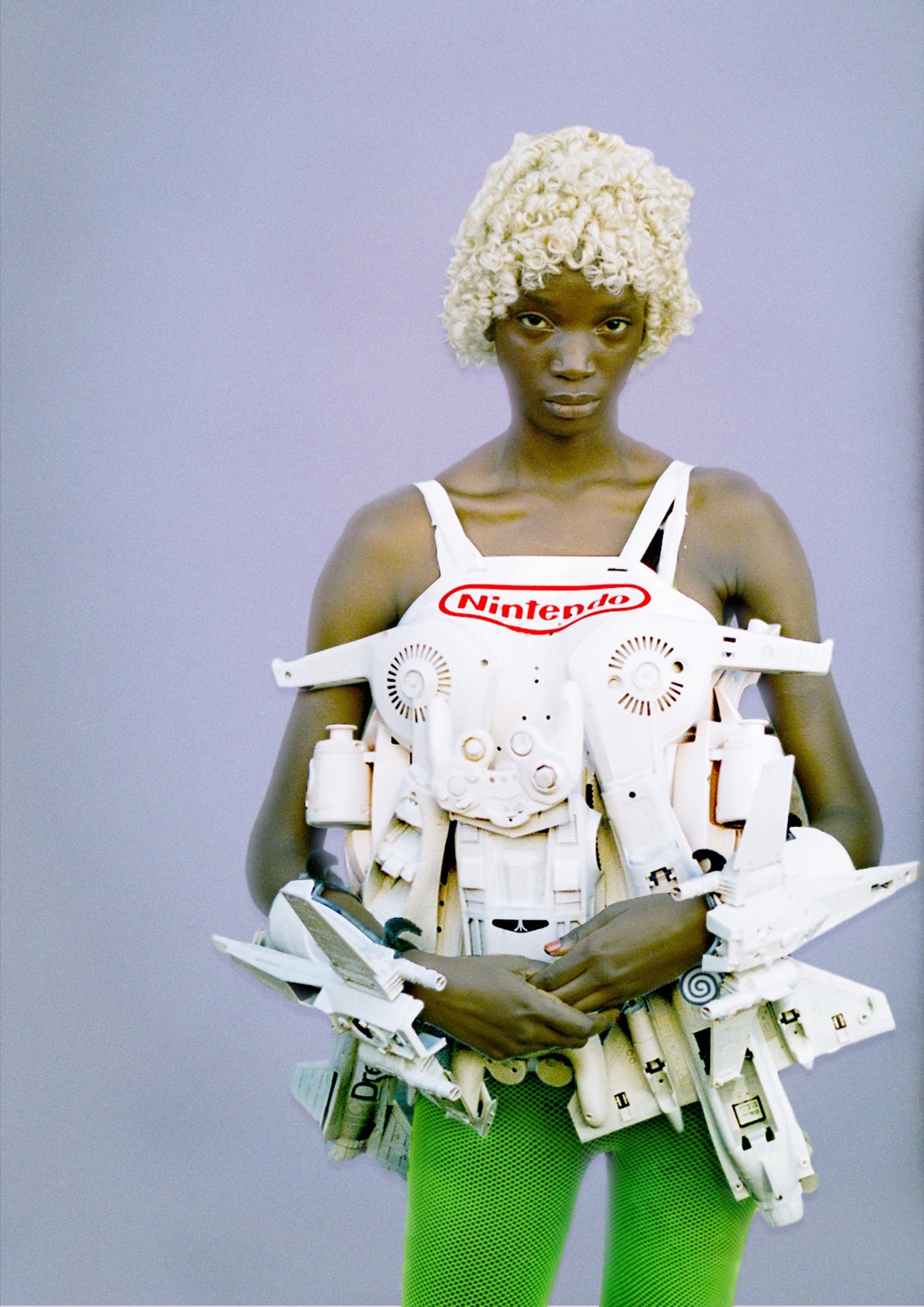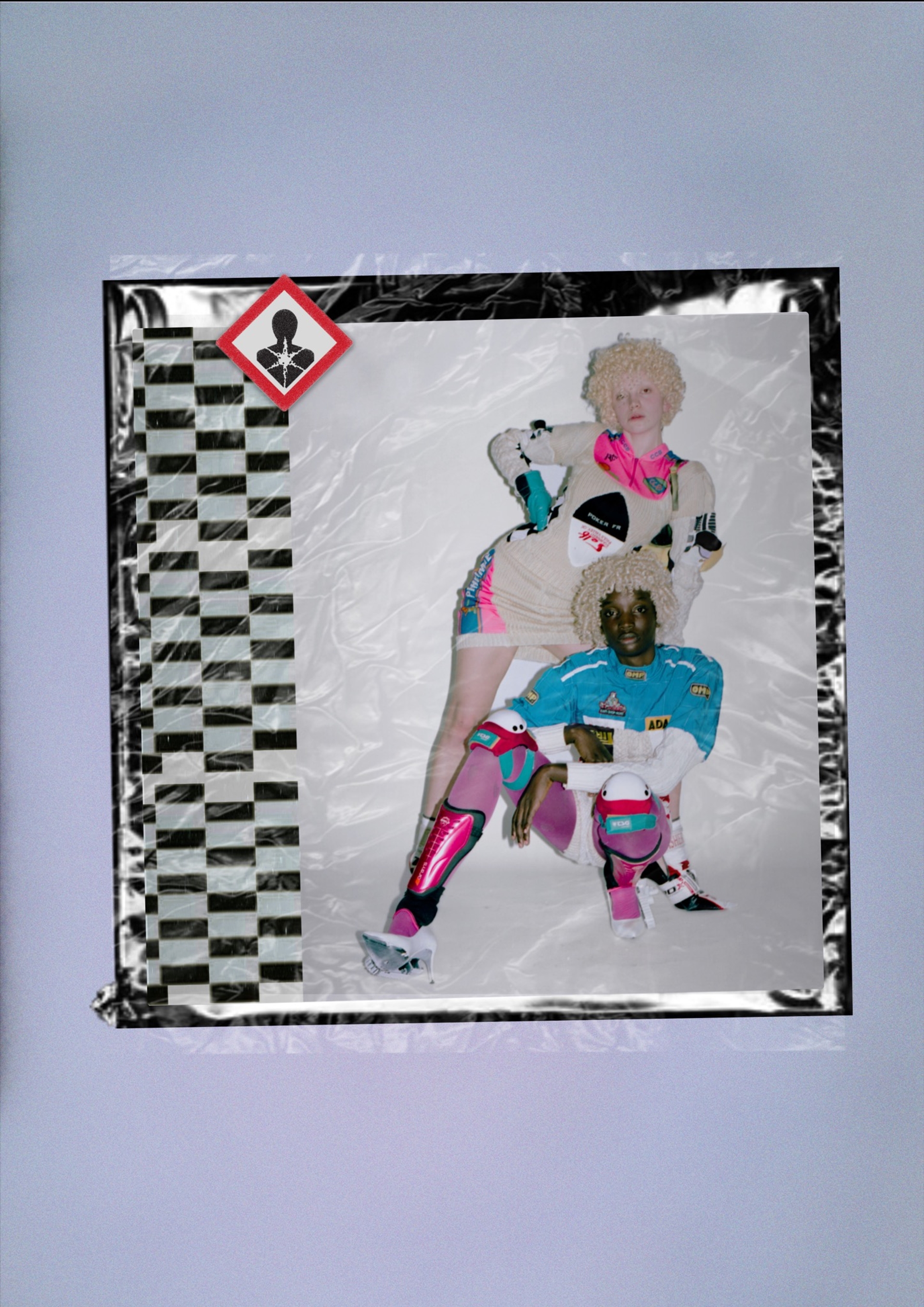Mutant Tomatoes From The Recent Future: PIERRE - LOUIS AUVRAY’s Console Couture
Distasteful as it might be to some parents, most children’s first experiences of extended narrative fiction take place within the sprawling universes in World of Warcraft, Red Dead Redemption, and Grand Theft Auto. When story-led video games began to shift millions of copies in the 1980s, the corporations that produced them promised new modes of access to those worlds, igniting an arms race of peripheral devices – headsets, visors, every kind of weapon, and a glove – that would augment the body and grant physical dominion over this alternate reality.
The French designer Pierre-Louis Auvray, a recent Central Saint Martin’s womenswear graduate, fixes real and imagined gaming hardware onto boots, hats, chest pieces, jerseys, and bodysuits. From joystick-topped helmets to a vest strung with console-colored jet fighters, Auvray’s designs, cataloged on his Instagram @forbiddenkn0wledge, seem more like a series of bionic interfaces than recognizable garments, like the blooper reel from a previous generation’s approximation of transhumanisms to come.
Auvray’s designs push the human body to its limit, and further: he makes thicc latex bodysuits inspired by wrestlers and mutant tomatoes. When an elfen-eared alien appeared in Gucci’s FW2017 campaign, those familiar with his preference for extraterrestrial models made so much noise that Alessandro Michele himself was forced to deflect accusations of plagiarism. As an artist adept at incorporating the unhinged tendencies of the memescape alongside a set of personal and deeply considered references – see below for a timely trashing of the fashion-world’s over-reliance on mood boards – Auvray’s case provides a unique insight into the relationship between too-big-to-fail fashion houses and early-career designers.
At Mowalola Ogunlesi’s recent SS20 runway, under the banner of non-profit Fashion East during London Fashion Week 2019, models wore trench coats with fuzzy, orb-like avatars by Auvray floating across the chest. In Mowalola’s leather world of Lagosian hot rod chic, the bloated lips and eyes seemed to manifest a digital spectator, drifting over content in a fug of exhaustion and dopamine dregs, like the cursed image that slides into view when you hit the selfie camera button at the wrong time. Creativity is a game, and Auvray’s work draws in eyeballs like conspiracy narratives draw in amateur detectives, a map of subtly-connected references in a bright, yet paranoid style.
Philip Maughan: We should probably start by discussing your muscle suits. They look like radioactive vegetables one minute, then like some sort of elegant Chinese floral vase the next. They’re aggressive, yet chic. How did the idea develop?
Pierre-Louis Auvray: I always wanted to make something that was reminiscent of that huge mutated Tetsuo scene from Akira. But the idea originated from this cool book of photographs of young wrestlers from all of America. I can’t remember the name of the photographer but there was this striking picture of a girl in red spandex holding an awesome pose. Later I ended up looking at pictures of giant tomatoes and my brain just made a connection. That was essentially the basis for my graduate collection.
There’s a clear link to sportswear – yet the clothes seem to present the body at breaking point, it’s the sweaty, thrombotic, rippling expression of a feeling, not the skinny ease of athleisure. How do you see the relationship your designs retain with sportswear?
I’m very interested in the way our body moves and where the lines break. The shoulders, elbows and knees provide great material, there’s always something happening there, with or without a garment – a bone showing, some wrinkles etc. Now it’s about exaggerating those features and sportswear is great for this! I’m all about stretchy fabrics: they take the shape of anything and have this smooth damp feeling.
Your Instagram charts an evolving interest in the alien, the creepy, involuntary eruptions that call to mind the porous shadow world of H.P. Lovecraft’s fiction. How did this interest emerge, and how has it informed your work?
Definitely with Alien the movie! It does a great job at being a horror movie but it’s also how I discovered the work of H.R. Giger. I remember being so stoked when I found out about him, it was so intricate and detailed but uncanny at the same time. I like his vision of what alien architecture could be: non-Euclidian, mixing biology and technology. To us it sounds horrific and gory but to another species it might not, so long as they don’t think and act like us. This is what Lovecraft is all about and I find it kind of absurd and funny, something I also aim for with my work. I hope nothing makes sense when someone looks at my Instagram.
You recently took part in a show in Madrid in which you overlaid thermal imaging tights to your muscle suits. Where did this idea come from? Why do you think parallel maps (like a map that shows heat or time rather than mass) might be compelling in our present moment?
Well, it was actually kind of a basic idea. I’d had people wearing this outfit a few times already, and apparently it gets really hot and sweaty in there, so the thought of showing the heat that emanates from the body to the garment came naturally. It reminded me of predator vision too. I love the Predator movies.
After a strikingly familiar alien figure walked Gucci’s AW17 show, a model carrying his head in his hands walked yours. How do you see the relationship between big designers, brands, and art school students? Is there a sense that they are watching? Was the head intended to draw attention to the symbiosis – or worse?
Most fashion houses work with moodboards – I think by now most people are aware of this – and I don’t think it’s a good way of doing anything. You lose track of all the references, you take the depth out of the work, and only keep what you find aesthetically pleasing. Also, not much credit is given where it’s needed when one works like that. We are saturated with so much imagery now that everything feels like free-to-use public property. I don’t think there’s anything personal about it but it is upsetting. The head was kind of a whatever moment. I decided to do it one day before the show and I like how you put that – a symbiosis. It was a little callback. I kind of wanted to give it long wavy brown hair, but then I was like maybe not.
Tell us about the video games (the virtual metaverses) that influence your aesthetic? Do you see a relationship between the twin hyperobjects of game-based entertainment and contemporary fashion?
My favorite thing with video games is the world building. I grew up playing a lot of RPGs like The Elder Scrolls, World of Warcraft etc. and I was obsessed by how story-driven they were. It was my first taste of what a coherent body of work could be like and I think it helped me a lot when I started designing. When you create a collection it’s good to have a strong narrative to guide you. Everything just falls into place if you make up good lore. It makes the process very satisfying. There is also the attraction of strong charismatic characters: this is what you’re looking for when you put together a look.
On a similar note – a number of the sweaters, shoes, and head pieces you’ve developed feature parts and accessories from late 80s and 90s console hardware. What do you find compelling about those early attempts at VR and interactive mechanics?
What I love about early console hardware the most is how they were conceived as an extension of the body, every side of it fits into a specific place in your hand and it allows you to have control and interact with a simulation. One of my favorite movies, eXistenZ by David Cronenberg took this to a whole other level. It features these cool bio controllers made out of flesh-like materials, teeth, bones and plugs that wire you to another reality. I’d love to explore that more with garments in the future. It would be a nice challenge because I’d still want it to be wearable.
Your BA show took medieval wrestling as its central theme – I’m especially keen on the winkle pickers – what drew you to the world of jesters, friars, strongmen, and troubadours, and was it useful?
The core theme of my collection was warfare, so while researching I found myself looking at engravings of medieval jousts. All these folks wearing colorful tights and puffy shirts or full-on armor, there was so much energy in these pictures and I tried to capture that. The winkle picker is my favorite type of shoe. I’ve been drawn to them ever since I was a kid. I was using kilometers of tape and newspaper to make the longest ones. They look like a weapon, also you can recreate that shape with lots of reconstructed materials so it’s very playful.
Your sweatshirts weave a quilt of references that appear to suggest more than they explain . . . Your online moniker “Forbidden Knowledge,” not to mention your posts, draw us to inspect the world of conspiracy theories. How earnest is your interest in hidden truths, and how are they made present in your design work?
I think it comes back to world building. I love the doubt that you’re left with after a full day watching conspiracy videos on YouTube. They can be harmful, though, if they’re part of one’s political agenda. Maybe we are so drawn to them because there seems to be so little transparency in this age. Like, politicians are out there on social media acting like everyday people, hoping to be relatable, yet we’ve never distrusted them so much. Conspiracies allow space to create the craziest narratives. Also, I love pretending to be an old prophet who hears truths when I slumber.
Finally, tell us about any collaborations you’ve found particularly joyful. What are you working on now?
I recently collaborated with Mowalola, who is an amazing designer, on some illustrations. We discussed the theme of the collection and I was given creative freedom to paint monsters. I did something airbrushy and colorful, and the end result was very satisfying! I’ve never really done prints before and was very honored to be asked to do this! Her clothes look amazing and she has such a strong vision. I always feel very grateful when someone I admire asks me to work on something with them. It’s also very stressful because I always want to prove myself up to the task. I doubt a lot. Hopefully it will get easier as time goes by.

